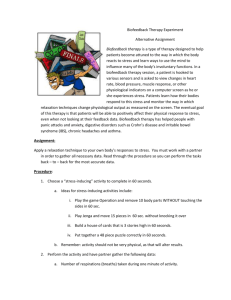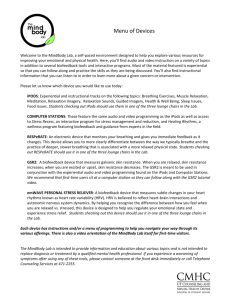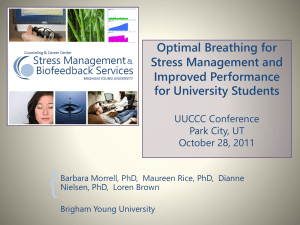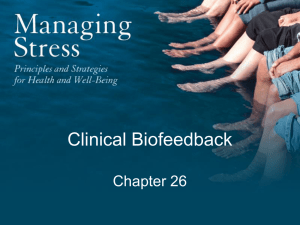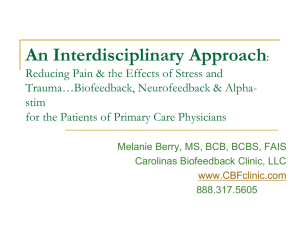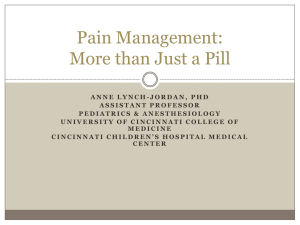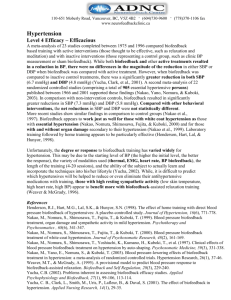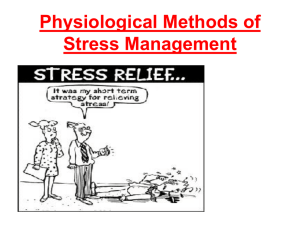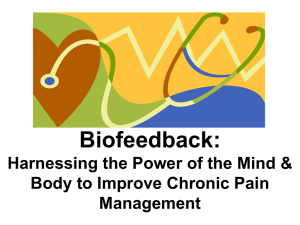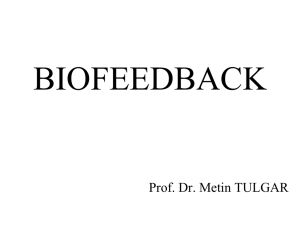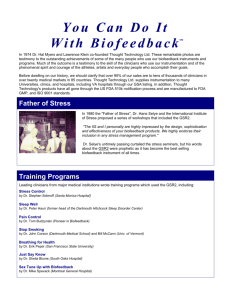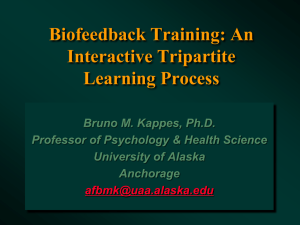Stress Management and Biofeedback Training
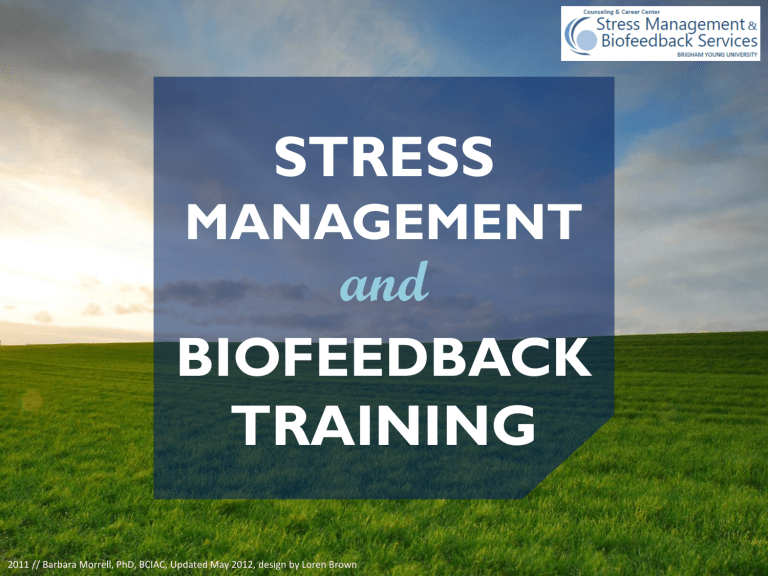
STRESS
MANAGEMENT
and
BIOFEEDBACK
TRAINING
2011 // Barbara Morrell, PhD, BCIAC, Updated May 2012, design by Loren Brown
Stress Management
Stress Management is like learning to drive.
Our Stress Response , the Fight/Flight/Freeze Response, is like an inborn gas pedal that revs up our mind & body in reaction to stress as well as danger.
Our Relaxation Response is like a brake we can apply to calm down when we are speeding out of control from stress.
What makes Stress Management so difficult?
Our inner gas pedal is automatic.
We go from 0 to 60 in an instant in response to any stressor
Our mind does not differentiate danger from stress
Our inner brake is not automatic.
It takes awareness and practice to
• Catch ourselves “speeding”
• Develop skills to relax “at will”
• Maintain appropriate cruising speed
• Make braking more automatic
Stress & the Mind / Body Connection
Resting or Working Mind and Body Stress Response : Faster, Stronger for Survival
Muscles: Contract as Needed, then Relax
Mind: Focused, Clear Thinking & Memory
Hormones: Regulating Normally
Heart Rate/Blood Pressure: Normal, good circulation
Breathing: Smooth, Deep, Slow
Stomach: Digesting normally
Sweat Glands: As needed to cool off
Immune System : Protecting the body
Emotions: Manageable
Muscles: Tense Up, Poised for Action
Mind: Instinctive; Higher thinking shuts down
Stress Hormones Released: Adrenalin, Cortisol
Heart Rate: Speeds Up to pump more blood to muscles
Breathing: Shallow and Quick
Stomach: Digestion shuts down;“butterflies”
Sweat Glands: More active
Immune System: Shuts down to conserve energy
Emotions: Fear, Anger, Panic Nervousness
Stress & Modern Man
=
PRIMITIVE STRESS RESPONSE HIGHLY DEVELOPED BRAIN STRESS
The fight or flight response becomes over-active and maladaptive in the fast-paced modern world of constant psychological stressors
The stress response impairs our concentration, working memory, rational thinking and ability to function.
Only humans carry our stress around with us:
Much of our stress comes from our worries, fears, expectations, regrets, selfcriticisms, and negative perceptions
Our stress level is determined more by our perception of the stressor than the stressor itself
What is supposed to be a burst of energy for survival results in chronic stress with many consequences for health and wellness
Why *Zebras Don’t Get Ulcers, Anxiety, Insomnia. . .
.
After they outrun the lion. . .
. . .they go back to grazing, playing, etc.
We need to stop running when we are not being chased!
* See Why Zebras don’t get Ulcers, Robert M. Sapolsky, 2004
Stress & Performance
high
Peak Performance
H low medium
LEVEL OF STRESS
Yerkes-Dodson Principle
Robert M. Yerkes, M.D. and John D. Dodson, M.D, 1908
L high
Normal Fight/Flight/Freeze
Responses to Psychological
Stress Overload
Decrease in Performance
Poor Concentration & Memory
Anxiety, Nervousness
Feeling Overwhelmed (Freeze)
Avoidance of Tasks (Flight)
Giving Up (all or nothing)
Emotions: Bottled up, Erupt,
Roller-Coaster (Fight or Flight)
Depression, Hopelessness
Awareness
Notice the signs of stress
Mental/Emotional Signs of Stress
• Poor concentration/focus
• Feeling Anxious
• Feeling Upset, Irritable, Angry, etc
• Feeling overwhelmed, helpless
• Wanting to avoid or run from tasks
• Mind racing
Physical Signs of Stress
• Muscle Tension
• Pounding Heart
• Chest or Stomach discomfort
• Cold and/or Sweaty hands
• Trembling or Shaking
Effective Stress Management = Effective Braking
Whenever we notice signs of stress, especially stress overload, that is the time to put on the brake
• Relaxation Skills
• Changing stress inducing
thoughts to stress reducing thoughts
• Physical Exercise
• Etc.
Relaxation Skills Training
They are called skills because they take
practice
like any other skill.
It takes only
10 minutes a day to learn the skills
Choose a time that fits into your routine:
At bedtime
Break from studying
Etc.
Deep Relaxation
Bring the car to a complete stop for a needed break from stress 10 or more minutes once a day …
Conditions our minds and bodies to more easily let go of tension and stress
Teaches skills to use as brief techniques throughout the day
Protects the Immune system
Helps prevent or improve stress related health problems
Brief Relaxation
Tapping the brake throughout the day as needed to calm ourselves when stressed
Brings us back to peak performance
Can be used proactively to prevent stress overload
• Deep breathing every hour for a few minutes
• Quick body scan every hour to prevent tension build-up
• Etc.
Once learned, any relaxation technique can be used as a brief technique.
Biofeedback
Any kind of feedback from the body
- Biofeedback programs measure stress indicators in the body
- Biofeedback helps with awareness of stress and tension
- Biofeedback training can teach us to release tension and stress
EMG / TEMP / SR Biofeedback
Muscle Tension (EMG)
• We tend to brace against stress
• Constant muscle tension can cause tiredness, pain, headaches, etc.
Hand Temperature (TEMP)
• The stress response pumps blood to the large muscles to power us up
• This decreases circulation to the hands and feet making them colder
• Hand temperature can range from 68◦ to 98◦
Sweat Gland Activity (SR)
• Sweat glands are the most reactive indicator of stress in our body
• Known as the Galvanic Skin Response
• Measured as Skin Resistance or Skin Conductance
Heart Rate Variability (HRV) Biofeedback
Measures Heart Rate and Heart Rhythms
Trains us to use diaphragmatic breathing and positive mental/emotional focus to achieve calmness and mental clarity
Teaches Autonomic Balance-- balance between our gas pedal and brake--for peak performance
One of the best ways to learn to “put on the brake”
*For more information see Introduction to Heart
Rate Variability PPT
• emWave: Learn diaphragmatic breathing
• Dual Drive: Calm breathing wins the race
• Relaxing Rhythms: Games & Activities improve calmness, emotional balance, and meditation
Awareness
Practice = Effective Stress Management
How will we support you in using the KNOWLEDGE and SKILLS you learn here in your daily life?
We will help you to choose an Awareness goal and
Practice goal
(examples on the back of the practice form)
We will refer you to appropriate resources
We will ask you about your goals, progress, stress, etc. when you return
We will help you customize your biofeedback and relaxation training for your stress issues.
Practice Resources
Website: google “BYU biofeedback”
Downloadable relaxation recordings
List of CD’s we use in the lab for checkout from library
Handouts for awareness, knowledge and techniques
Stress Management Tips
EZ-Air breath pacer
Download FREE for 30 days: http://bfe.org/
EmWave program and EZ-Air on computers in
Career and Academic Support Center, WSC 2590
Take ID to check out sensor
Two Ways to Access Biofeedback Services
Make an Appointment for One-on-One Biofeedback Training o Severe anxiety, depression, etc.
o Headaches, sleep issues, etc.
o Muscle tension, hand temperature, and galvanic skin response biofeedback o Personalized relaxation recordings
And/Or Come During Open Biofeedback Hours* o Before and/or between biofeedback appointments o Class assignments o For typical college student stress management issues o Fun Interactive biofeedback games on individual computer stations o Intensive Relaxation training
*See current schedule (link). The first three individuals are admitted each hour.
